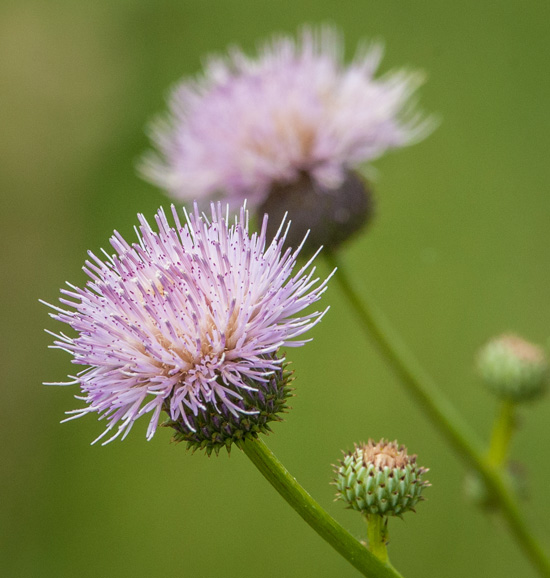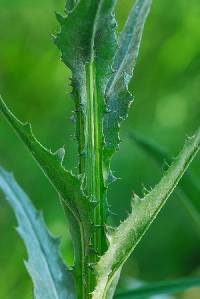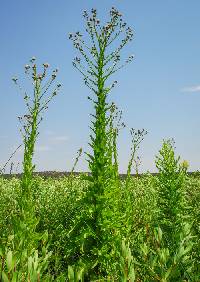Cirsium wrightii
|
|
|
|
Family: Asteraceae
Wright's Thistle, more...Wright thistle
|
Biennials or monocarpic perennials, 100-300 cm; taproots short with many slender, fibrous lateral roots. Stems usually 1, erect, glabrous to ± tomentose; branches many, usually restricted to distal part of stem, ascending. Leaves: blades oblong to elliptic, 10-60 × 5-20 cm, unlobed and merely spinulose to irregularly dentate or shallowly to deeply pinnatifid, lobes ± broadly triangular, separated by wide sinuses, obtuse to acute, sometimes coarsely toothed or lobed, main spines slender, 1-3 mm, faces thinly arachnoid, soon glabrescent; basal often present at flowering, petioles slender, ± winged; cauline progressively reduced, proximal petiolate, mid and distal sessile, long-decurrent; distalmost linear to narrowly elliptic, bractlike, spinulose to irregularly dentate or shallowly lobed. Heads many, in openly paniculiform arrays, borne singly at tips of peduncles. Peduncles slender, 1-15 cm. Involucres ovoid to hemispheric, 1-2 × 1-2 cm, thinly arachnoid, glabrate. Phyllaries in 8-9 series, strongly imbricate, green, lanceolate (outer) to linear (inner), abaxial faces with prominent glutinous ridge; outer and middle appressed, bodies entire, apices acute, spines spreading, slender, ca. 1 mm; apices of inner often flexuous, acuminate, flat, scabrid-ciliolate. Corollas white to pink-purple, 19-21 mm, tubes 9-10 mm, throats 4-4.5 mm, lobes 5-7 mm; style tips 2-3.5 mm. Cypselae brown, ca. 4.5 mm, apical collars stramineous, 0.2 mm; pappi 15-16 mm. Flowering summer-fall (Aug-Oct). Springs, seeps, marshes, stream banks, often in alkaline soil; of conservation concern; 1100-2600 m; Ariz., N.Mex., Tex.; Mexico (Chihuahua, Sonora). Wright´s thistle occurs from the mountains of south-central New Mexico eastward to the cienegas of the adjacent southwestern Great Plains. Cirsium wrightii is listed by the state of New Mexico as a species of concern. The one known site in Cochise County, Arizona, is apparently historic. Hybrids are known between Cirsium wrightii and C. vinaceum in the Sacramento Mountains of New Mexico. I have observed hummingbird visits to the heads of both species, though C. wrightii shows none of the apparent adaptations to hummingbirds (P. L. Barlow-Irick 2002) that are seen in such taxa as C. occidentale var. candidissimum, C. andersonii, and C. arizonicum.
FNA 2006, McDougall 1973, Emory et al. 1859 Duration: Perennial Nativity: Native Lifeform: Forb/Herb General: Biennials or monocarpic perennial herbs; 100-300 cm tall from taproots; stems usually 1, erect, glabrous to - tomentose; branches many, usually restricted to distal part of stem, ascending. Leaves: Blades oblong to elliptic, 10-60 5-20 cm, unlobed and merely spinulose to irregularly dentate or shallowly to deeply pinnatifid, lobes - broadly triangular, obtuse to acute, sometimes coarsely toothed or lobed, main spines slender, 1-3 mm, basal lvs often present at flowering, petioles - winged; cauline progressively reduced, proximal petiolate, mid and distal sessile, long-decurrent, spinulose to irregularly dentate or shallowly lobed. Flowers: Heads many, in openly paniculiform arrays, borne singly at tips of peduncles; peduncles 1-15 cm; involucres ovoid to hemispheric, 1-2 1-2 cm, glabrate; phyllaries strongly imbricate, green, lanceolate (outer) to linear (inner), abaxial faces with prominent glutinous ridge, spines spreading, ca. 1 mm; corollas white to pink-purple, 19-21 mm; flowering Aug-Oct. Fruits: Brown, ca. 4.5 mm, apical collars stramineous, 0.2 mm; pappi 15-16 mm. Ecology: Springs, cienegas, seeps, marshes, stream banks, often in alkaline soil; 3608-8530 ft (1100-2600 m). Distribution: se AZ, n to s NM, n MEX. Notes: Of conservation concern in New Mexico. Not known from Arizona except for one historic specimen near San Bernadino Ranch, currently San Bernadino Wildlife Refuge. If found in AZ, alert local specialists, herbaria or managers. Distinguished from other thistles in the southwest by being small-headed (involucres 1-2 cm), corollas white to pink-purple, bisexual florets, mid-stem leaf bases extending down stem as spiny wings, and heads borne on long peduncles (1-15 cm) in open panicles. Ethnobotany: Other species in the genus: compound decoction of root for back pain, stalks chewed for stomach pain, pounded stalk pulp used for face sores, to dry infections; peduncles and stems eaten fresh, raw or boiled. Synonyms: Cnicus wrightii (A. Gray), Carduus wrightii A.Heller Editor: FSCoburn, 2014 Etymology: Cirsium is derived from the Greek kirsion, "a kind of thistle," in turn from kirsos, "a swollen vein or welt," because they were used as a remedy against such things. Wrightii is named for Charles Wright, botanist, land surveyor and teacher who was a member of the United States-Mexico Boundary Survey (1851) where many new plants were discovered. Many common species were named for him. |



